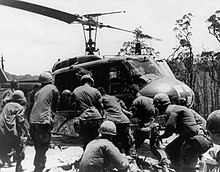Operation Apache Snow
| Operation Apache Snow | |||||||
|---|---|---|---|---|---|---|---|
| Part of the Vietnam War | |||||||
 101st Airborne wounded are loaded on a medevac helicopter | |||||||
| |||||||
| Belligerents | |||||||
|
|
| ||||||
| Commanders and leaders | |||||||
|
| Ma Vinh Lan | ||||||
| Strength | |||||||
Ten artillery batteries | 29th Regiment | ||||||
| Casualties and losses | |||||||
|
|
US body count: 675 killed 3 captured | ||||||
Operation Apache Snow was a joint U.S. Army and Army of the Republic of Vietnam (ARVN) military operation during the Vietnam War designed to keep pressure on the People's Army of Vietnam (PAVN) units in the A Sầu Valley and prevent them from mounting any attacks on the neighboring coastal provinces.
Background
The A Sầu Valley was an important corridor for the PAVN and Viet Cong (VC), who frequently used it to transport supplies from Laos into South Vietnam as well as employed it as staging area for attacks. Previous sweeps of the valley in Operation Delaware and Operation Dewey Canyon in the previous year had resulted in over 2,000 enemy casualties, but were unsuccessful at removing the PAVN from the valley.[1]
Apache Snow was planned as an operation involving ten battalions. The initial assault force consisted of troops from the 187th, 501st, and 506th Infantry Regiments of the 101st Airborne Division, the 9th Marine Regiment, and the ARVN 1st Division.[2] The plan was to block escape routes into Laos and assault enemy formations and strongholds.
Operation
The operation began on 10 May 1969. The PAVN mostly conducted a fighting retreat in the valley. The 29th Regiment eventually made a stand in elaborate previously prepared bunker positions on Hill 937. After ten days of fighting, which involved 11 infantry assaults up Hill 937 primarily by the 3rd Battalion, 187th Infantry (resulting in heavy U.S. losses), U.S. forces managed to destroy the PAVN fortifications and capture the hill. The resulting battle became known to the soldiers as Hamburger Hill, an up-to-date reference to the Korean War Battle of Pork Chop Hill.
As the hill had no military significance aside from the presence of the PAVN, it was abandoned by U.S. forces within a few weeks of its being taken. Operation Apache Snow continued until 7 June, with the PAVN conducting a fighting retreat and U.S. troops making limited contact with them.
Aftermath
The operation met its limited objective of pressuring the PAVN forces in the valley. However, the valley continued to be used as staging area for attacks in northern South Vietnam. The U.S. claimed that the month‑long operation accounted for 675 PAVN killed, three prisoners, 241 individual and 40 crew‑served weapons captured, and more than 100,000 rounds of ammunition discovered. Operation Apache Snow resulted in a strategic victory for U.S. and ARVN troops, but the abandonment of Hill 937 was a moral defeat that caused widespread outrage from U.S. forces and the American public.[3]
References
- ^ Olson, James S. (2008). In Country: The Illustrated Encyclopedia of the Vietnam War. Metro Books. pp. 419–20. ISBN 9781435111844.
- ^ Bowman, John S. (1985). The Vietnam War: An Almanac. World Almanac Publications. p. 184. ISBN 0911818855.
- ^ Summers Jr., Harry G. (1985). The Vietnam War Almanac. New York: Random House. pp. 184–5. ISBN 0-7394-4290-2.
External links
- "Operation Apache Snow and the Battle for Hamburger Hill". Retrieved 2009-01-09.
- "Operation Apache Snow". Retrieved 2009-01-09.
- "Operation Apache Snow". Retrieved 2009-01-09.
- "The summer offensive in the A Shau valley". Retrieved 2009-01-09.
